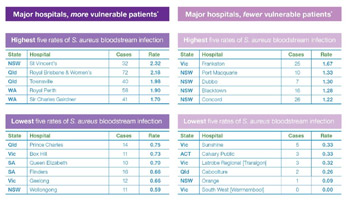6% Fall in Golden Staph Cases

6% Fall in Golden Staph Cases
Australia's major public hospitals have recorded a marked fall in the rate of healthcare-associated -Golden Staph' bloodstream infections, the latest report from the National Health Performance Authority shows.
The number of these potentially deadly infections fell by 100, from 1,721 in 2012–13 to 1,621 in 2013–14. The report shows major public hospitals reported 88 fewer cases in 2013–14 compared to the previous year.
However, the report also shows that large differences remain between individual hospitals, with patients still up to three times more likely to catch this bloodstream infection depending on the hospital where they receive care.
Golden Staph, more correctly known as Staphylococcus aureus (S. aureus), is a bacterium often found on the skin of healthy people. It is relatively harmless unless it enters the body, where it can cause serious illness if it gets into the bloodstream. Most cases can be treated by antibiotics, but there are more serious antibiotic-resistant strains. Estimates suggest 20 to 35% of people who experience healthcare-associated S. aureus bloodstream infections die from this or a related cause, and some patients (such as those with impaired immunity) are more susceptible than others.
Today's report only counts healthcare-associated cases of S. aureus bloodstream infections, which means it identifies infections that patients develop during the course of medical care or treatment provided by hospitals.
To enable fair comparisons, the report allocates hospitals into four peer groups: -major hospitals with more vulnerable patients', -major hospitals with fewer vulnerable patients', -large hospitals with more vulnerable patients' and -large hospitals with fewer vulnerable patients'. Australia's major and large public hospitals together accounted for nearly 90% of the healthcare-associated S. aureus bloodstream infections reported in 2013–14.
The report highlights variation in the rate of healthcare-associated S. aureus bloodstream infections across similar hospitals:
At major hospitals with more vulnerable patients, the rate of infection was more than three times higher at some hospitals than others, ranging from 0.59 cases per 10,000 patient bed days at Wollongong Hospital to 2.32 at St Vincent's Hospital (NSW)
At major hospitals with fewer vulnerable patients the rate of infection showed a similar level of variation, ranging from 0 cases per 10,000 patient bed days at South West [Warrnambool] (Vic) to 1.67 at Frankston Hospital (Vic). National Health Performance Authority CEO Dr Diane Watson said through nationally consistent reporting hospitals are able to see their results and how they compare with hospitals that are similar in size and services. Public reporting of healthcare-associated infection rates abroad is associated with a substantial reduction in these types of infections.
'While the reduction of about 100 cases is an improvement, we should remember that every healthcare-associated bloodstream infection is both potentially deadly and preventable," Dr Watson said.
'Differences in the rate of infection suggest there is an opportunity for hospitals to continue to learn from each other to lower infection rates."
Individual hospital results, including results for private hospitals, are available at www.myhospitals.gov.au.
MORE



